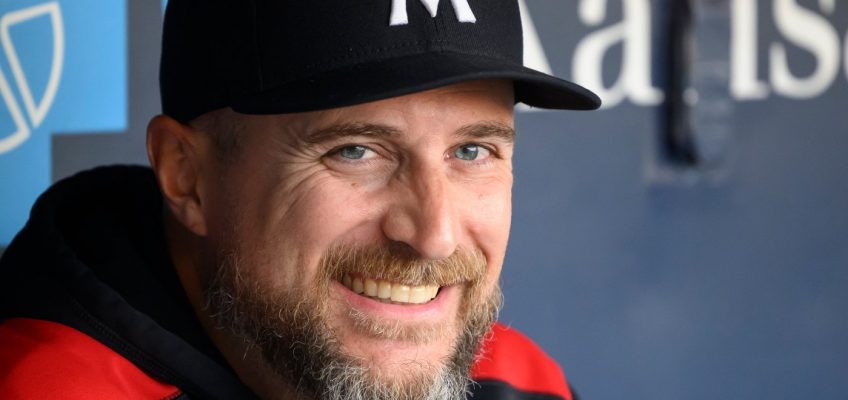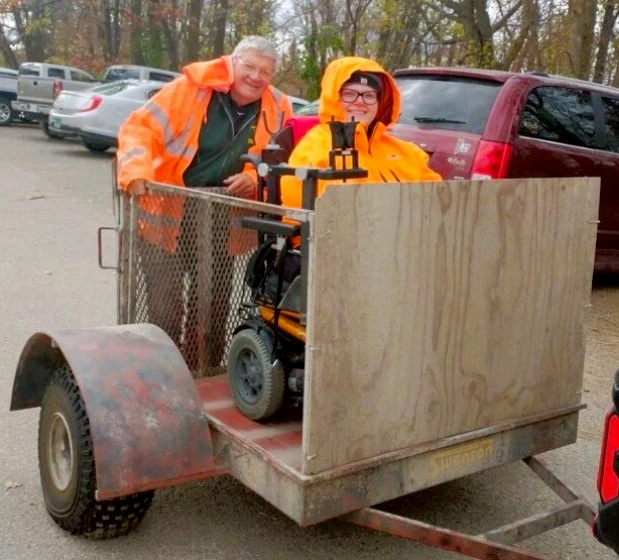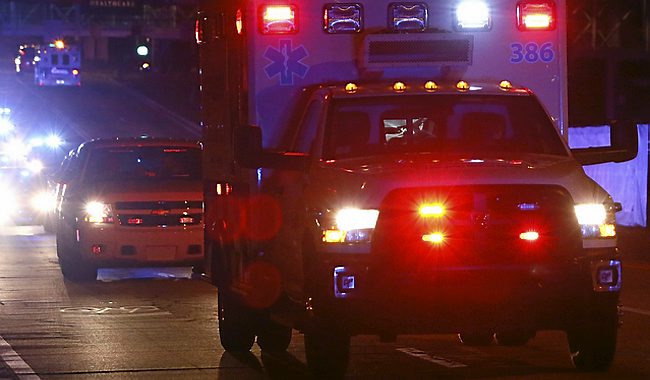POLK COUNTY, Minn. – For three days every October, Rydell National Wildlife Refuge becomes a Northwoods deer camp.
It’s been that way since 1995.
This year, Options Resource Center for Independent Living in East Grand Forks, Minn., marks the 30th anniversary of its Accessible Deer Hunt, an event for hunters with both physical and emotional disabilities. Open to 20 people, the Accessible Deer Hunt gives participants the opportunity to enjoy hunting and camaraderie in a deer camp environment they otherwise might not be able to experience.
This year’s Accessible Deer Hunt is set for Oct. 16-18.
Dave Bennett, left, former manager of Rydell National Wildlife Refuge, and Gary Heit of Fergus Falls, Minn., load a small doe onto a trailer in Oct. 2008 during the Options Accessible Deer Hunt at Rydell NWR in Polk County, Minn. The hunt marks its 30th anniversary during this year’s event, set for Oct. 16-18, 2025. Hosted by Options Resource Center for Independent Living in East Grand Forks, Minn., the event is for hunters with both physical and emotional l disabilities. Open to 20 people, the Accessible Deer Hunt gives participants the opportunity to enjoy hunting and camaraderie in a deer camp environment they otherwise might not be able to experience. (Brad Dokken / Forum News Service)
“We try to get people that have hunted as a person with a disability, people new to hunting and give people an opportunity to talk between themselves and learn the ropes from each other,” said Randy Sorensen, executive director of Options. “Over the years, we’ve had people with intellectual disabilities, physical disabilities, mental disabilities – if you’re able to legally hold a firearm and buy a license, we will let you hunt.
“We don’t restrict it to just any one disability group.”
Adaptive equipment is available for hunters who might need it, but most bring their own, Sorensen says. At about 2,200 acres, Rydell NWR is an ideal setting for the hunt, he said.
Getting started
According to Sorensen, the Options Accessible Deer Hunt was the brainchild of Jay Johnson, who founded the nonprofit in 1986 as a way to help people with disabilities live independently. A fierce advocate for the disabled, Johnson was seriously injured in a 1978 motorcycle accident that left him paralyzed from the chest down.
Spending the rest of his life in a nursing home wasn’t an option for Johnson, so he dedicated his life to helping others with disabilities.
Upon learning about the high deer population at Rydell, which was privately owned until 1992, when it became a national wildlife refuge, Johnson approached refuge staff about establishing a hunt for people with disabilities, recalls Mickey Kaiser of Crookston, Minn., a friend of Johnson’s who has been an Accessible Deer Hunt volunteer for all but a handful of years.
Mickey Kaiser of Crookston, Minn., has been a volunteer for the Accessible Deer Hunt at Rydell National Wildlife Refuge in Polk County, Minn., for all but a couple of years in the event’s 30-year history. (Randy Sorensen / Options Resource Center for Independent Living)
Along with another friend, Chuck Olson, “we were like the three amigos back then,” Kaiser said.
“We hunted and fished everywhere together,” he said. “And Jay had heard about when the refuge opened up to public hunting, so he went out there with a proposal to start a handicapped and a youth hunt, and it just started rolling from there.”
Rydell no longer offers a youth hunt, but the Options Accessible Hunt is still going strong. Johnson died in a 2001 ATV crash.
Different approach
Many accessible hunts are “passive,” Sorensen says, meaning hunters are provided with a blind and a place to hunt. They must have someone along to assist, whether it be a volunteer, a friend or family member. Interaction with other disabled hunters is limited.
That works well for people with hunting experience or someone in their life to assist, Sorensen says, “but it doesn’t do as much as it could for people that want to try to hunt or test the water.”
Instead, he says, Johnson and others at Options explored setting up a hunt to pair people with disabilities, who have hunting experience, with people who have no experience.
The drawing card, Sorensen says, was food, and the Visitor Center at Rydell provided the ideal setting for hosting hunting camp-style meals.
Sorensen has been involved with the hunt for all 30 years.
“People up here in the North Country always socialize around food, and it makes people more relaxed,” Sorensen said. “Thanks to the refuge, we were able to do some cooking and offer food and use the Visitor Center there as a hub where people can come in and eat lunch and eat supper and then get to know each other and talk about the hunt and tell lies and stories and exchange ideas and how best to facilitate hunting as a person with a disability.”
Hunters, volunteers and other participants enjoy an evening meal Friday, Oct. 14, 2011, during the Options Accessible Deer Hunt at Rydell National Wildlife Refuge in Polk County near Erskine, Minn. In October 2025, Options Resource Center for Independent Living in East Grand Forks, Minn., marks the 30th anniversary of its Accessible Deer Hunt, an event for hunters with both physical and emotional disabilities. Open to 20 people, the Accessible Deer Hunt gives participants the opportunity to enjoy hunting and camaraderie in a deer camp environment they otherwise might not be able to experience. (Randy Sorensen / Options Resource Center for Independent Living)
Options buys the food, and a volunteer cooking crew serves up noontime and evening meals such as burgers and brats the first afternoon of the hunt, along with heartier evening fare such as pork chops with mashed potatoes and gravy, ham and au gratin potatoes.
The hunt includes noontime and evening meals all three days.
Sorensen says Options is fortunate to have partners, including Rydell NWR staff and the Minnesota Department of Natural Resources, that allow the hunt to happen. The DNR collaborates with refuge staff to hold the hunt outside traditional deer season dates. For logistical reasons, the hunt doesn’t begin until noon and continues through the end of shooting hours each of the three days.
It’s all about opportunity, Sorensen says.
Individualized approach
Some hunters like to do everything themselves, while others appreciate the help from friends, family or volunteers, Sorensen says. Between kitchen helpers, people who shuttle hunters to and from their stands or help track and field-dress deer, it takes 50 to 60 volunteers, he says, including a core of 10 or 12 and others who fill in as time permits.
Students from the University of Minnesota-Crookston’s Natural Resources program also volunteer their time and help with “boning and skinning and cooking and setting tables and cleaning and all that sort of stuff,” Sorensen said.
“We’ve gotten a lot and kept a lot of volunteers, and that has really helped us,” he said. “(Volunteers) can sign up for as little or as much as they can do.”
As a longtime volunteer, Kaiser of Crookston says he enjoys helping wherever he’s needed.
“I like doing it all – getting them into the stand and getting them into the right spot,” he said. “I always used to love tracking the deer because I was good at it. I rarely lost a deer if somebody hit one. But then we started getting the college kids from UMC out there, and those kids are so eager and willing to go, we just set them free. I would just sit back and watch after that.
“This is easy for me because I’ve run around that refuge for so long. I know where everything is.”
Playing a part
Gregg Knutsen, manager of Rydell NWR, says Sorensen and the volunteers deserve the credit for the hunt’s longevity. As refuge owners, the U.S. Fish and Wildlife Service provides a venue for the hunt, he says, but the organizers do the rest.
“I feel honored that we can play a small part in providing the land base, helping out a little bit with site prep and providing a spot for people to enjoy the food and the camaraderie and a spot to get warm,” Knutsen said. “For me as a manager and for some of our other staff, it is really rewarding.
“It very much feels like a deer camp,” he added. “We kind of half jokingly tell people that the refuge turns into a deer camp those three days. We close the refuge to all other public activities.”
Even during the COVID-19 pandemic with all of the restrictions that were in place, Options was able to host the hunts in 2020 and 2021, with a limit of 10 hunters and no social gathering. The only year out of 30 that Options didn’t hold a hunt was 2013, when the federal government shut down because lawmakers couldn’t reach a budget agreement, Sorensen says. With the U.S. Fish and Wildlife Service and other federal agencies shut down, the refuge was closed.
Sorensen says he counts that year anyway.
“Everything was set up, ready to go,” he said. “They passed a budget two days before we were to offer the hunt, but there were so many people … there was just too much to do in two days.”
Undated courtesy photo of Randy Sorensen, executive director, Options Resource Center for Independent Living. (Forum News Service)
Congress as of Friday, Sept. 26, hadn’t reached a full budget agreement to maintain government funding past the Sept. 30 deadline and avoid a similar scenario.
As the Accessible Deer Hunt approaches the 30-year milestone, Sorensen says there’s more to the event for those who participate than getting a deer. Many participants say the camaraderie is just as important, if not more so, he says.
“It’s been a great 30 years,” Sorensen said.
For more information on the Accessible Deer Hunt or other Options programs, contact Sorensen at 800-726-3692 or by email at Randy@myoptions.info.
Continental duck numbers hold steady, feds say in status report
Motorist shot in leg on I-35 in Chisago County; cops heard target shooting nearby
DNR rejects calls to halt hunting dog training at Keystone Woods
Minnesota deer season largely unchanged from 2024




